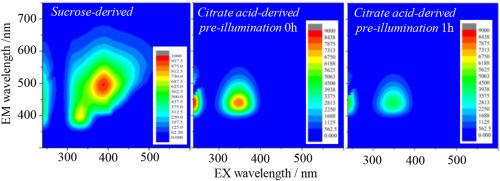生物质衍生的碳量子点光催化消毒机制的新见解
IF 11.6
2区 材料科学
Q1 CHEMISTRY, PHYSICAL
引用次数: 0
摘要
碳量子点(CQDs)作为水处理中光消毒试剂的潜在替代品,近年来引起了人们的广泛关注。然而,CQDs的光消毒机制尚未得到充分探讨。在这项研究中,我们重点研究了两种典型的含氮CQDs (NCQDs),即柠檬酸和蔗糖,通过仔细分析它们的表面化学、光吸收/光致发光特性和活性氧(ROS)的产生,来研究它们在消毒机制上的差异。我们的研究结果表明,两种NCQDs的光消毒效果是由不同的ROS驱动的,这是由它们不同的化学结构造成的。柠檬酸衍生的NCQDs会产生超氧阴离子(O2•-),导致自身结构变化和显著的消毒效果恶化。与之相比,蔗糖衍生的NCQDs是一种更稳定的光消毒选择,因为它们主要产生单线态氧(1O2),能有效杀死细菌,同时对碳结构的影响最小。蔗糖衍生的NCQDs也被确定为含有氧化石墨烯的粉末状和膜基复合材料光消毒的主要贡献者。这些结果强调了在评估不同CQDs的光消毒应用潜力时了解其潜在机制和考虑其稳定性的重要性。本文章由计算机程序翻译,如有差异,请以英文原文为准。

New insights into the mechanisms of biomass-derived carbon quantum dots for photocatalytic disinfection
As a potential substitute for photo-disinfection reagents in water treatment, cost-effective and eco-friendly carbon quantum dots (CQDs) have recently attracted significant interest. However, the photo-disinfection mechanism of CQDs remains insufficiently explored. In this study, we focus on two typical nitrogen-containing CQDs (NCQDs) derived from common biomass substrates, namely citric acid and sucrose, to examine their differences in disinfection mechanisms by carefully analyzing their surface chemistry, light absorption/photoluminescence properties, and reactive oxygen species (ROS) generation. Our findings reveal that the photo-disinfection effects of the two NCQDs are driven by different ROS, resulting from their distinct chemical structures. In contrast to citric acid-derived NCQDs, which generate superoxide anions (O2•-) that cause self-structural changes and significant disinfection deterioration, sucrose-derived NCQDs are a more stable option for photo-disinfection, as they primarily produce singlet oxygen (1O2), which is effective in killing bacteria while exerting minimal impact on the carbon structure. Sucrose-derived NCQDs were also identified as the primary contributors to photo-disinfection in both powdered and membrane-based composites containing graphene oxide. These results highlight the importance of understanding the underlying mechanisms and considering the stability of different CQDs when evaluating their potential for photo-disinfection applications.
求助全文
通过发布文献求助,成功后即可免费获取论文全文。
去求助
来源期刊

Carbon
工程技术-材料科学:综合
CiteScore
20.80
自引率
7.30%
发文量
0
审稿时长
23 days
期刊介绍:
The journal Carbon is an international multidisciplinary forum for communicating scientific advances in the field of carbon materials. It reports new findings related to the formation, structure, properties, behaviors, and technological applications of carbons. Carbons are a broad class of ordered or disordered solid phases composed primarily of elemental carbon, including but not limited to carbon black, carbon fibers and filaments, carbon nanotubes, diamond and diamond-like carbon, fullerenes, glassy carbon, graphite, graphene, graphene-oxide, porous carbons, pyrolytic carbon, and other sp2 and non-sp2 hybridized carbon systems. Carbon is the companion title to the open access journal Carbon Trends. Relevant application areas for carbon materials include biology and medicine, catalysis, electronic, optoelectronic, spintronic, high-frequency, and photonic devices, energy storage and conversion systems, environmental applications and water treatment, smart materials and systems, and structural and thermal applications.
 求助内容:
求助内容: 应助结果提醒方式:
应助结果提醒方式:


